Gattendorf Castle
| Gattendorf Castle | ||
|---|---|---|
|
The destruction of the castle in 1523 |
||
| Alternative name (s): | Gattendorf Castle | |
| Creation time : | around 1356 | |
| Castle type : | Hilltop castle | |
| Conservation status: | Castle courtyard, remains of a waiting room and moat have been preserved | |
| Standing position : | Knighthood | |
| Construction: | nothing special | |
| Place: | Gattendorf | |
| Geographical location | 50 ° 19 '18 " N , 11 ° 59' 46" E | |
|
|
||
The Gattendorf castle in Gattendorf ( Upper Franconia ) stands on the foundations of the former Knights seat Gattendorf , which existed until the early 16th century.
History of the castle complex
Knight seat of the von Sparneck family
The castle Gattendorf as a rampart with a defense tower was probably founded in the course of the development of the country by the Counts of Vohburg. It was first mentioned on March 6, 1294. In 1366 the castle, which had been destroyed by robbery activities, was rebuilt. From 1356 to 1562 it was owned by the von Sparneck family . Two lines of the family were based in Gattendorf. An important representative was Hans von Sparneck , who negotiated with the Hussites at court in 1430 .
Alban von Dobenck outlined the appearance of the castle: "Gattendorf Castle rises on a sizeable hill above the village, steep slopes shield the property on different sides". Based on observations of the state at that time by von Dobenck in 1792, one can assume an oval floor plan. A moat, which can be crossed by a bridge, surrounds the small courtyard, at the end of which is the main building. Remnants of a control room are located in front of the bridge, directly on the steep slope.
Destruction in the Franconian War in 1523
Main article: Wandereisen woodcuts from 1523

In the middle of the 16th century, the robber baron Hans Thomas von Absberg kidnapped merchants from the imperial cities in Franconia and Swabia on their trade trips and demanded a large ransom for their release. The Lords of Sparneck supported him in his feud. Gett, a representative of this family, appeared in 1519 at Gattendorf, the castle that had been owned by the Sparnecker for a long time. In 1522 an imperial servant was attacked on the Knittlinger Steige. Gett von Sparneck is also said to have been among the troops that supported the Absberg in the attack. The Swabian Federation sent its troops in 1523 and razed a total of 23 predatory nests to the ground. Five of the destroyed castles belonged to the Sparneckers. Gattendorf was set on fire on July 10, 1523; the remains were blown up to prevent the owners from returning.
The woodcut shows the castle from around today's baroque palace. The hill drops steeply on the right in the direction of the houses belonging to Schloßgattendorf, some of which are also burning. The castle includes a heaped rampart, a palisade fence and, recognizable by the wooden bridge, a moat . The castle wall encloses at least one main building and a tower in a round shape. The top section of the tower is made of half-timbering . All parts of the castle are on fire. The von Sparneck family's coat of arms is emblazoned above the entrance. In the foreground of the picture are the troops of the Swabian League, on the left the cavalry and on the right foot troops, each armed with spears, in the middle there are two drawn cannons. The two accompanying riders carry burning sticks with them to ignite the cannons.
Further building history
The plant was mentioned in the border regulation between Saxony and Brandenburg the following year, but it was not completely rebuilt. The remains were poorly repaired around 1562, but the decline could not be stopped permanently. The building was used as a warehouse, granary and brewery. The dilapidated brewery burned down in 1895 and remained in ruins. Today, a lined moat and a larger vaulted cellar point to the medieval origins of this building. The surrounding mountain forest is a natural monument .
History of the baroque palace

In 1700 the margravial tax administrator Wolf-Christoph Schmidt acquired the manor from Margrave Christian Ernst and began building a baroque palace. The family, to which the swan in the municipal coat of arms reminds, resided there until 1779. The castle is currently used as a restaurant.
literature
- Peter Braun: The gentlemen from Sparneck. Family tree, distribution, brief inventory . In: Archives for the history of Upper Franconia . Volume 82, 2002, pp. 71-106.
- Alban von Dobenck : History of the extinct family of the von Sparneck . In: Archives for the history of Upper Franconia . Volume 22, Issue 3, 1905, pp. 1-65 and Volume 23, Issue 1, 1906, pp. 1-56.
- August Gebeßler : City and District of Hof . The Art Monuments of Bavaria , Brief Inventories , Volume VII . Deutscher Kunstverlag , Munich 1960, p. 58f.
- Hans Hofner : Gattendorf - A witness of Vogtland history and culture after Hans Hofner . 1963.



